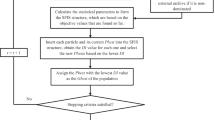Abstract
In any meta-heuristic algorithm, each search agent must move to the high-fitness areas in the search space while preserving its diversity. At first glance, there is no relationship between fitness and diversity, as two key factors to be considered in selecting a guide for the solutions. In other words, each of these factors must be evaluated in its specific and independent way. Since the independent ways to evaluate the fitness and diversity usually make any meta-heuristic consider these factors disproportionately to choose the guides, the solutions’ movements may be unbalanced. In this paper, we propose a novel version of the Particle Swarm Optimization (PSO) algorithm, named Dual Fitness PSO (DFPSO). In this algorithm, not only fitness and diversity of the particles are properly evaluated, but also the abilities to evaluate these features are integrated to avoid the abovementioned problem in determining the global guide particles. After verification of the DFPSO via applying them to several benchmark functions, it is applied to solve a real-world optimal conjunctive water use management problem. The objective is minimizing shortages in meeting irrigation water demands under several climatic conditions. The optimal results suggest that while the water demands are desirably met, the cumulative groundwater level (GWL) drawdown is highly decreased to help maintain the sustainability of the aquifer, demonstrating the high efficiency of the DFPSO to also handle the practical engineering problems.




Similar content being viewed by others
Data availability
Data and the codes of the algorithms used in this paper are available upon request.
References
Afshar A, Zahraei A, Marino MA (2010) Large-scale nonlinear conjunctive use optimization problem: Decomposition algorithm. Journal of Water Resources Planning and Management ASCE 136(1):59–71
Burt OR (1964) The economics of conjunctive use of ground and surface water. Hilgardia 36(2):25–41
Chen Y, Li L, Xiao J, Yang Y, Liang J, Li T (2018) Particle swarm optimizer with crossover operation. Eng Appl Artif Intell 70:159–169
Fazlali A, Shourian M (2018) demand management based crop and irrigation planning using the simulation-optimization approach. Water Resour Manage 32:67–81
Hakli H, Uguz H (2014) A novel particle swarm optimization algorithm with Levy flight. Appl Soft Comput 23:333–345
Holland JH (1992) Genetic algorithms. Sci Am 267:66–72
Hollander HM, Mull R, Panda SN (2009) A concept for managed aquifer recharge using ASR-walls for sustainable use of groundwater resources in an alluvial coastal aquifer in Eastern India. Phys Chem Earth 34:270–278
Kennedy J, Eberhart RC (1995) Particle swarm optimization. In: Proceedings of the IEEE international conference on neural networks, vol. IV, pp.1942–1948. Piscataway, NJ, Seoul, Korea
Kennedy J, Mendes R (2002) Population structure and particle swarm performance. in Proc IEEE Congr. Evol. Comput. (CEC), pp. 1671–1676
Kerebih MS, Keshari AK (2021) Distributed simulation-optimization model for conjunctive use of groundwater and surface water under environmental and sustainability restrictions. Water Resour Manage 35:2305–2323
Liang JJ, Qin AK, Suganthan PN, Baskar S (2006) Comprehensive learning particle swarm optimizer for global optimization of multimodal functions. IEEE Trans Evol Comput 10(3):281–295
Liang JJ, Suganthan PN (2005) Dynamic multi-swarm particle swarm optimizer. in Pro IEEE Conf Swarm Intell Symp (SIS), pp. 124–129
Liu W, Wang Z, Zeng N, Yuan Y, Alsaadi FE, Liu X (2021) A novel randomized particle swarm optimizer. Int J Mach Learn & Cyber 12:529–540
Majedi H, Fathian H, Nikbakht-Shahbazi A, Zohrabi N, Hassani F (2021) Multi-objective optimization of integrated surface and groundwater resources under the clean development mechanism. Water Resour Manage 35:2685–2704
Mendes R, Kennedy J, Neves J (2004) The fully informed particle swarm: Simpler, maybe better. IEEE Trans Evol Comput 8(3):204–210
Mirjalili S, Mirjalili SM, Lewis A (2014) Grey wolf optimizer. Adv Eng Softw 69:46–61
Rashedi E, Nezamabadi-Pour H, Saryazdi S (2009) GSA: a gravitational search algorithm. Inf Sci 179:2232–2248
Ratnaweera A, Halgamuge SK, Watson HC (2004) Self-organizing hierarchical particle swarm optimizer with time-varying acceleration coefficients. IEEE Trans Evol Comput 8(3):240–255
Rezaei F, Safavi HR (2020) GuASPSO: a new approach to hold a better exploration–exploitation balance in PSO algorithm. Soft Comput 24:4855–4875
Rezaei F, Safavi HR, Mirchi A, Madani K (2017a) f-MOPSO: An alternative multi-objective PSO algorithm for conjunctive water use management. J Hydro-Environ Res 14:1–18
Rezaei F, Safavi HR, Zekri M (2017b) A hybrid fuzzy-based multi-objective PSO algorithm for conjunctive water use and optimal multi-crop pattern planning. Water Resour Manage 31(4):1139–1155
Tian D, Zhao X, Shi Z (2019) DMPSO: Diversity-Guided Multi-Mutation Particle Swarm Optimizer. IEEE Access 7:124008–124025
Wang D, Tan D, Liu L (2018) Particle swarm optimization algorithm: an overview. Soft Comput 22:387–408
Wei F, Zhang X, Xu J, Bing J, Pan G (2020) Simulation of water resource allocation for sustainable urban development: An integrated optimization approach. J Clean Prod 273:122537
Wu G, Qiu D, Yu Y, Pedrycz W, Ma M, Li H (2014) Superior solution guided particle swarm optimization combined with local search techniques. Expert Syst Appl 41:7536–7548
Yekom Consulting Engineers (2013) Studies for updating Iran’s integrated water plan (Gavkhouni River Basin). Final report, Water and Wastewater section, Ministry of Energy (In Persian)
Zhou J, Fang W, Wu X, Sun J, Cheng S (2016) An opposition-based learning competitive particle swarm optimizer. In Proceedings of the 2016 IEEE Congress on Evolutionary Computation (CEC), Vancouver, BC, Canada, pp. 515–521
Acknowledgements
This work was supported by Iran’s National Science Foundation (INSF) with grant No. 97001722, which is greatly appreciated.
Funding
No funding was received for conducting this study.
Author information
Authors and Affiliations
Contributions
F.R.: Methodology, Software, Formal analysis, Validation, Investigation, Visualization, Writing – original draft preparation. H.S.: Conceptualization, Writing – review and editing, Supervision.
Corresponding author
Ethics declarations
Ethical Approval
Not applicable.
Consent to Participate
Not applicable.
Consent to Publish
Not applicable.
Competing Interests
The authors declare that they have no conflict of interest.
Additional information
Publisher's Note
Springer Nature remains neutral with regard to jurisdictional claims in published maps and institutional affiliations.
Rights and permissions
About this article
Cite this article
Rezaei, F., Safavi, H.R. Sustainable Conjunctive Water Use Modeling Using Dual Fitness Particle Swarm Optimization Algorithm. Water Resour Manage 36, 989–1006 (2022). https://doi.org/10.1007/s11269-022-03064-w
Received:
Accepted:
Published:
Issue Date:
DOI: https://doi.org/10.1007/s11269-022-03064-w




